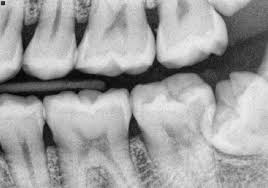Bitewing X-Rays

Bitewing X-Rays
Each bitewing captures the exposed (visible) part of your upper and lower teeth as well as half of their roots and supporting bone.
Bitewing x-rays help dentists detect decay, especially between teeth. They also help dentists detect changes to your jawbone caused by gum disease.
It is recommended to take bitewings during your dental check-up, at least once every two years. This will help diagnose problems at an early stage, even before you have symptoms.
FAQ x-ray
Recommendations for each individual depend on their current dental and medical history as well as the condition of their mouth. Those with increased risk for dental problems may need x-rays as often as every six to twelve months, while others with no recent dental issues may require them less often. Taking dental x-rays is a crucial part of a complete examination. Without them, cavities, infiltration under fillings or crowns, bone loss chronic infections, and other abnormalities of the teeth or jaw can go undetected. In fact, x-rays are a vital preventative tool to ensure that small problems don’t progress into more extensive (and expensive) ones! It is our recommendation that our patients have their Bitewing x-rays once every two years and a Panoramic every 5 years. Other types of x-rays such as a 3D CBCT or a Lateral Ceph may need to be taken based on treatment needs and insurance requirements (for claim submissions or Pre-determinations).
The amount of radiation from dental x-rays is negligible. Four Bitewing x-rays have been estimated to be the amount of radiation received from a 2 hour airplane flight. Radiation exposure is typically measured in units called millirem (mrem). Each year, the average person receives about 620 mrem of radiation from all natural and man-made sources
combined. The amount of radiation you get from a single digital Bitewing x-ray is 0.1 mrem.
Compare this to:
- One plane ride from Malta to mainland Europe, round trip: 5 mrem
- Sunlight & other cosmic radiation: 35 mrem
- Food and water for 1 year: 40 mrem
- Breathing normally for 1 year (from radon in air): 228 mrem
- 1 full body CT scan: 1000 mrem
- Digital x-rays significantly reduce the level of radiation, by as much as 70-80%, utilizing sensors that replace traditional photographic x-ray film.
- Your dentist uses the “As Low As Diagnostically Achievable” (ALADA) Method to
customize x-ray frequency based on your risk factors to minimize your exposure.
Tell your dentist if you may be pregnant, or you have been told to limit x-ray exposure.

Clinic Opening Hours
- Monday - Friday 08:00AM - 07:00PM
- Saturday 08:00AM - 04:00PM
- Sunday / Holidays Closed

